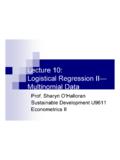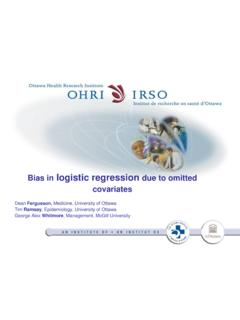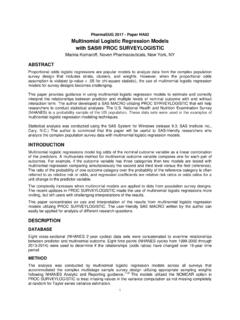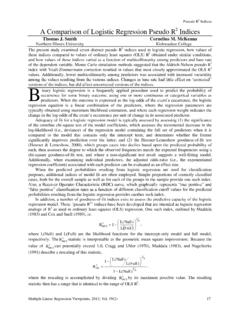Transcription of MULTINOMIAL LOGISTIC REGRESSION: USAGE …
1 Quantitative Methods Inquires 288 MULTINOMIAL LOGISTIC regression : USAGE AND APPLICATION IN RISK ANALYSIS Anass BAYAGA School of Initial Teacher Education (SITE), Faculty of Education, University of Fort Hare, South Africa E-mail: Abstract: The objective of the article was to explore the USAGE of MULTINOMIAL LOGISTIC regression (MLR) in risk analysis. In this regard, performing MLR on risk analysis data corrected for the non-linear nature of binary response and did address the violation of equal variance and normality assumptions. Additionally, use of maximum likelihood (-2log) estimation provided a means of working with binary response data. The relationship of independent and dependent variables was also addressed. The data used included a cohort of hundred risk analyst of a historically black South African University.
2 In this analysis, the findings revealed that the probability of the model chi-square ( ) was , less than the level of significance of ( p< ). Suggesting that there was a statistically significant relationship between the independent variable-risk planning (Rp) and the dependent variable-control mechanism (control mecs) (p< ). Also, there was a statistically significant relationship between key risks assigned (KSA) and time spent on risk mitigation. For each unit increase in confidence in control mecs, the odds of being in the group of survey respondents who thought institution spend too little time on Rp decreased by Moreover, the findings revealed that survey respondents who had less confidence in control mecs were less likely to be in the group of survey respondents who thought institution spent about the right amount of time on risk planning.
3 Key words: Binary variable; Log odds ratio; LOGISTIC regression model; (log) Likelihood ratio statistic; -2 Log Q; Wald statistic; Model fit; -2 Log L. Quantitative risk analysis 1. Context of study Modeling of risk processes such as risk awareness, risk identification, monitoring and reporting, planning and mitigation etc is among rather difficult subjects tackled by risk analyst especially in applying MULTINOMIAL LOGISTIC regression in dynamic (social) setting. Invariably though, social science research (Yu, Lai & Wang, 2008; Fan & Xiao, 2006) problems somewhat call for analysis and prediction of a dichotomous1 outcomes. Traditionally, such research outcomes were addressed by either ordinary least squares (OLS) regression or linear discriminant function analysis (Hosmer & Lemeshow, 2000).
4 However, both techniques, as a result of their nature, depend on strict statistical assumptions, thus, normality of independent variables, linearity of relationships, multicollinearity among independent variables, equal dispersion matrices for discriminant analysis (Tabachnick et al., 2001). These assumptions which are not easily observed in a dynamic setting are part of multiple2 regression . Introduction of MULTINOMIAL LOGISTIC regression was an alternative regression analysis to cater for conditions that do not necessarily obey the assumptions listed above with the exception of multicollinearity (Hosmer & Lemeshow, 2000). In the last decade, the technique, like other univariate and multivariate data analysis methods, started to find a Quantitative Methods Inquires 289 prominent place in the medicine, engineering and the manufacturing industries.
5 This development led researchers in risk analysis to build more accurate and useful statistical models by applying it in risk analysis (Liebenberg & Hoyt, 2003; Hosmer & Lemeshow, 2000). Meanwhile, despite being in use in general statistical analysis for many years, it has received rather little attention in the risk analysis literature compared to other regression applications regarding modelling of explanatory and response variable (Liebenberg & Hoyt, 2003;Hosmer & Lemeshow, 2000). Recent studies (Crane, Gibbons, Jolley, Van Belle, 2007; Hedeker, 2003; Menard, 2002; Tabachnick, Fidell & Osterlind, 2001; Harrell, 2001; Hosmer & Lemeshow, 2000) have noted that modelling relationship between explanatory (predictor) and response variables is a fundamental activity encountered in risk analysis.
6 The accounts of these studies suggest that simple linear regression is often used to investigate the relationship between a single predictor variable and a single response (dependent) variable. But, when there are several explanatory variables though, MULTINOMIAL LOGISTIC regression is used. However, often the response (dependent variable) as some of the authors argued (Menard, 2002; Tabachnick et al., 2001; Harrell, 2001; Hosmer & Lemeshow, 2000) is not a numerical value. Instead, the response is simply a designation of one of two possible outcomes (a binary response); example, alive or dead, success or failure, yes or no. Data involving relationship between explanatory variables and binary responses proliferate in just about every discipline from engineering to the natural sciences, to medicine etc.
7 Invariably though, what remains a matter of concern for many practitioners and theorists of risk analysis in University is the questions of how to model relationship between explanatory variables and a binary response variable (Liebenberg & Hoyt, 2003; Tabachnick et al., 2001; Harrell, 2001; Hosmer & Lemeshow, 2000). Scholars (Hamilton, 2003; Hendrickx, 2000; McCullagh, 1980) have argued that the difficulty for both practitioners and theorists in modeling of risk processes steams from the social setting within which risk parameters are applied. Additionally, the authors suggested that little scholarly literature has delved into application of MULTINOMIAL LOGISTIC regression in analysis of risks parameters particularly in a University context.
8 Whiles, there remain little studies being conducted in risk analysis with regards to MLR in the context of a University, many recent studies (Van Gelderen, Thurik & Bosma, 2006; Jalilvand & Switzer, 2005; McNeil, Frey & Embrechts, 2005; Mishra & El-Osta, 2002) have encouraged its USAGE due to its relevance to the field of risk analysis. Following the above, the paper explored the application of MULTINOMIAL LOGISTIC regression via University-wide risk analysis. It does this by using concepts from simple and multiple linear regressions which are carried over to MLR. Additionally, ideas of maximum likelihood estimation are central to the modelling of the MLR data. MULTINOMIAL LOGISTIC regression The MULTINOMIAL (polytomous) LOGISTIC regression model is a simple extension of the binomial LOGISTIC regression model.
9 It is used when the dependent variable has more than two nominal or unordered categories, in which dummy coding3 of independent variables is quite common. In using MULTINOMIAL LOGISTIC regression in risk analysis, the dependent (response) variable is dummy coded into multiple 1/0 variables (cf. sections 3 for details). This means that there is a variable for all categories but one, so if there are M categories, there will be M-1 dummy variables. All but one category has its own dummy variable. Each category s dummy variable has a value of 1 for its category and a 0 for all others. One category, the reference category, does not need its own dummy variable, as it is uniquely identified by all the other variables being 0.
10 With regards to the above, risk analyst using MULTINOMIAL LOGISTIC regression can then estimate a separate binary LOGISTIC regression model for each of those dummy variables. The result is M-1 binary LOGISTIC regression models. The most significant factor to consider here is that each one tells the effect of the predictors of risk on the probability of success in that category, in comparison to the reference category. Noting though that each model has its own intercept and regression coefficients- the reason being that predictors of risk analysis processes could affect each category differently (cf. sections 2 & 3 for details). Quantitative Methods Inquires 290 Why MULTINOMIAL LOGISTIC regression instead of other Techniques?









